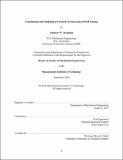| dc.contributor.advisor | Karl Iagnemma. | en_US |
| dc.contributor.author | McDaniel, Matthew W | en_US |
| dc.contributor.other | Massachusetts Institute of Technology. Dept. of Mechanical Engineering. | en_US |
| dc.date.accessioned | 2011-04-25T14:17:51Z | |
| dc.date.available | 2011-04-25T14:17:51Z | |
| dc.date.copyright | 2010 | en_US |
| dc.date.issued | 2010 | en_US |
| dc.identifier.uri | http://hdl.handle.net/1721.1/62326 | |
| dc.description | Thesis (S.M.)--Massachusetts Institute of Technology, Dept. of Mechanical Engineering, 2010. | en_US |
| dc.description | This electronic version was submitted by the student author. The certified thesis is available in the Institute Archives and Special Collections. | en_US |
| dc.description | Cataloged from student submitted PDF version of thesis. | en_US |
| dc.description | Includes bibliographical references (p. 107-112). | en_US |
| dc.description.abstract | To operate autonomously, unmanned ground vehicles (UGVs) must be able to identify the load-bearing surface of the terrain (i.e. the ground) and obstacles. Current sensing techniques work well for structured environments such as urban areas, where the roads and obstacles are usually highly predictable and well-defined. However, autonomous navigation on forested terrain presents many new challenges due to the variability and lack of structure in natural environments. This thesis presents a novel, robust approach for modeling the ground plane and main tree stems in forests, using 3-D point clouds sensed with LIDAR. Identification of the ground plane is done using a two stage approach. The first stage, a local height-based filter, discards most of the nonground points. The second stage, based on a support vector machine (SVM) classifier, operates on a set of geometrically-defined features to identify which of the remaining points belong to the ground. Finally, a triangulated irregular network (TIN) is created from these points to model the ground plane. Next, main stems are estimated using the results from the estimated ground plane. Candidate main stem data is selected by finding points that lie approximately 130cm above the ground. These points are then clustered using a linkage-based clustering technique. Finally, the stems are modeled by fitting the LIDAR data to 3-D geometric primitives (e.g. cylinders, cones). Experimental results from five forested environments demonstrate the effectiveness of this approach. For ground plane estimation, the overall accuracy of classification was 86.28% and the mean error for the ground model was approximately 4.7 cm. For stem estimation, up to 50% of main stems could be accurately modeled using cones, with a root mean square diameter error of 13.2 cm. | en_US |
| dc.description.statementofresponsibility | by Matthew W. McDaniel. | en_US |
| dc.format.extent | 112 p. | en_US |
| dc.language.iso | eng | en_US |
| dc.publisher | Massachusetts Institute of Technology | en_US |
| dc.rights | M.I.T. theses are protected by
copyright. They may be viewed from this source for any purpose, but
reproduction or distribution in any format is prohibited without written
permission. See provided URL for inquiries about permission. | en_US |
| dc.rights.uri | http://dspace.mit.edu/handle/1721.1/7582 | en_US |
| dc.subject | Mechanical Engineering. | en_US |
| dc.title | Classification and modeling of forested terrain using LIDAR sensing | en_US |
| dc.title.alternative | Classification and modeling of forested terrain using Light Detection And Ranging sensing | en_US |
| dc.type | Thesis | en_US |
| dc.description.degree | S.M. | en_US |
| dc.contributor.department | Massachusetts Institute of Technology. Department of Mechanical Engineering | |
| dc.identifier.oclc | 712947484 | en_US |
